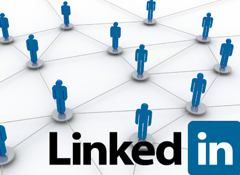As the most popular and powerful online professional network, with over 300 million members around the world, LinkedIn is arguably the best place online to build a portfolio of professional contacts and connect with like-minded professionals.
The site has a simple mission: to get the world’s professionals connected in the interests of success and productivity. And there are plenty of success stories which have LinkedIn to thank to at least some degree.
But not everyone is making the most out of LinkedIn, and there are many who let opportunities go wasted. In this guide I shall walk you through the process of finding new clients on LinkedIn and provide you with some helpful advice on making the most out of this service.
Searching With LinkedIn
In the first case we shall assume that you know the person/company you want to reach out to, which makes things very easy. All you have to do is search for the name/company on any LinkedIn page, and if they are registered, they will appear. The amount of profile information available to you will depend on their privacy settings.
But what if you don’t have a specific name or company to search for? This is no problem, as LinkedIn offers good tools for prospective searching. In fact, LinkedIn’s search functionality is one of the best things about it.
The important thing here is to know how to search effectively. The following tips will help:
Search for job roles, skills and anything else that relates to your work.
Search for agencies as well as individuals.
Use advanced search settings. These really help you to be specific and get back results that are actually useful.
Make use of Boolean search operators to sort the relevant matches from the irrelevant matches.
LinkedIn Groups offer an excellent way to get connected to clients and people who share the same professional interests, and there are loads and loads of them. Search from the search bar or the ‘Groups You May Like’ page.
Making Connections
Finding new client is the easy part – connecting with them is harder.
One option is to send an invitation to connect with you. If they accept your invitation, you will become 1st-degree connections and you will both have access to each other’s profiles and be able to send messages.
The snag here is that you will need the recipient’s email address in order to send an invitation to connect.
Once you have a 1st-degree network, you can then use the free ‘Introductions’ feature to introduce yourself to users who are 2 or 3 degrees away from you, by requesting an introduction from one of your connections. This method of finding new clients on LinkedIn is usually successful, because the recipient will see that you both have a user in common. What you do need however is a reliable 1st degree connection and the ability to give a good first impression.
If you can’t find the email address and you don’t have the right (or enough) 1st degree connections with which to send introductions to connect, you should go with InMail. InMail is a powerful tool that lets you directly contact members that you are not connected to, but you must use your InMails wisely because you only get a limited amount each month (you have to pay for them if you have a basic account).
Important Extras
If you want to remain anonymous when browsing profiles, head to the Privacy & Settings page. Unless you check the anonymous setting, other people will be able to find you through their “Who’s Viewed Your Profile?” page.
It is very useful to set up a detailed, CV-style account before you begin searching. LinkedIn offers lots of tools that help you branch out and get connected, and these work at their best when you have a comprehensive profile. Of course, a comprehensive profile is also good for your exposure.
Let Other Clients Find You
Don’t forget – ensuring that people can find you is just as important as knowing how to effectively find new clients, because you never know when that perfect opportunity will come knocking. The best way to open yourself up to good prospects is to create a strong and dependable network of users in your professional field, and to optimise your profile page for searches. I would highly recommend searching online for advice and tips on improving your LinkedIn page.
